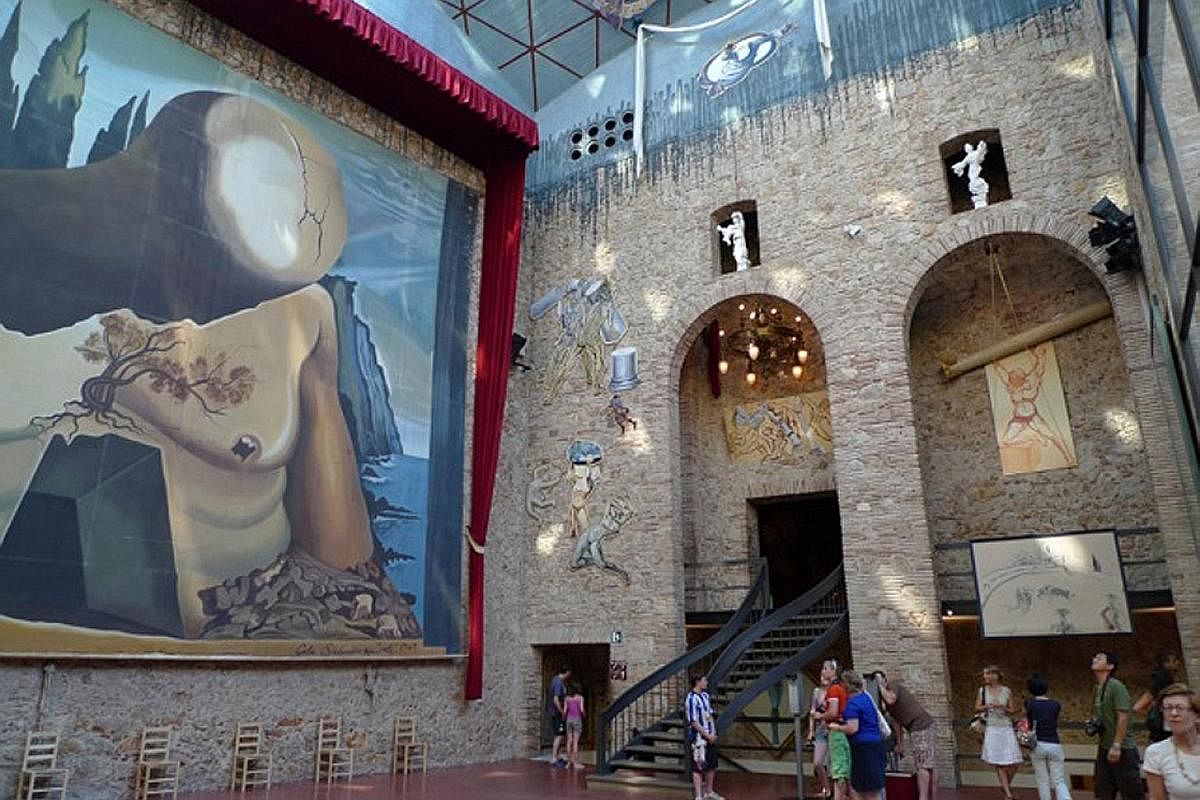-
GETTING THERE
-
Singapore Airlines flies direct from Singapore to Barcelona twice a week. From Barcelona, take a train (20 minutes to 1 hour 40 minutes) or hire a car and drive north to Girona.
-
TIPS
• To see everything there is to see in Girona and with time to relax, I recommend spending a week in the region.
• Girona is beautiful all year round, but for the best weather, go between April and November.
• In Girona, as well as the rest of Spain, lunch usually starts at 1.30pm and lasts till 3.30pm. Dinner is from 8.30 to 11.30pm.
There will be plenty of bars where people have tapas and wine or cava (Spanish sparkling wine) for a snack between noon and 6pm, especially in towns and destinations along the coast.
Many people will settle for a dinner of tapas, travelling from one establishment to another.
Travel Black Book: Ambassadors Series
Birthplace of Salvador Dali
The best of home: Ambassadors to Singapore provide an insider's guide to their favourite destinations


Who: Mr Miguel Navarro Portera, 68, Ambassador of Spain to Singapore. He and his wife, Dr Romana Sadurska-Navarro, 66, have lived in Singapore since December 2014
Favourite destination: The province of Girona is north of Barcelona, in Catalonia, Spain, and also sometimes known as Costa Brava.
I consider it a must-see for any visitor to Barcelona and particularly for second-time travellers to Spain.
Just 40 minutes by high-speed train or about 11/2 hours from Barcelona by car, this part of Spain is graced with a pleasant Mediterranean climate, waving green landscapes dotted with mediaeval stone villages, a beautiful and largely well-preserved rugged coast with stunning cliffs, coves and long beaches, excellent golf courses, as well as the Pyrenees mountain range providing a beautiful background.
SEE
Figueres, a town in Girona province, is the birthplace of artist Salvador Dali, and where he spent most of his life. It is home to the Dali Theatre and Museum (www.salvador-dali.org/en), where you can see many of his artworks and learn about his life.
Take a tour of the fisherman-style house in Port Lligat (tinyurl.com/y9635zqc), near the popular seaside town of Cadaques - Dali's principal home and where he lived and worked until his wife Gala's death in 1982. After her death, he moved into the mediaeval castle he bought for her in Pubol.
Gala Dali Castle Pubol (tinyurl.com/ycs8f8rd) was completely run down when he bought it and because Gala and Dali restored it together, the entire building is imbued with his surrealist influence.
These three sites, known as the Dali Triangle, are must-visits in the region. As you drive from one to the other, take the picturesque small roads, which offer plenty of photo opportunities and pass through Monells and Madremanya, two beautiful mediaeval villages.
Girona, the province's capital, has one of the most well-preserved mediaeval quarters in Spain. Its cinematic stairs and winding alleyways attracted the attention of the directors of Game Of Thrones and the old quarter served as the set for the city of Braavos in the television series.
Many scenes were filmed around Girona's cathedral, which is one of the oldest in Spain and boasts the second widest nave (22m) of any church in the world, after that of St Peter's Basilica in Rome.
You can also visit the quarter's Arab Baths, the pedestrianised Rambla and the iron bridge which was designed by Gustav Eiffel, the French architect behind the Eiffel Tower.
Girona's Jewish quarter, a labyrinth of cobbled mediaeval streets and squares, is one of the best-preserved Jewish quarters in the world.
Visit The Museum of Jewish History (www.girona.cat/call/eng), which tells the story of Catalonia's mediaeval Jewish communities and the community in Girona.
There are many beautiful routes along the coast. Travel south towards the municipality of Tossa de Mar, which I consider Girona's greatest coastal jewel, along 25km of windy road that provides stunning panoramic views from the cliff tops. Once you arrive, have lunch at La Cuina de Can Simon (www.restaurantcansimon.com).
Another route is along Girona's northern coast, passing through Torroella de Montgri towards L'Escala, the ruins of Ampurias (also known as Empuries, the remains of an ancient Greek town), then to Sant Pere de Rodes (tinyurl.com/y7yxsfcg), a well-restored 10th-century Benedictine monastery with spectacular views over the Cap de Creus National Park.
After lunch at Miramar (restaurantmiramar.com/en) in Llanca, descend towards Cadaques and Port Lligat to see Dali's summer house.
EAT
Girona is world-famous for its restaurants. The city is home to El Celler de Can Roca (www.cellercanroca.com), which was named the best restaurant in the world in 2013 and 2015 on the World's 50 Best Restaurants list. This year, it is at No. 3.
Book as far in advance as possible. In 2015, it received more than 200,000 reservation requests. It accepts reservations 11 months in advance, but I suggest making one at least six months before.
Girona province has 16 Michelin- starred restaurants. Its most iconic was el Bulli, of which I was a fortunate and enthusiastic customer - until it closed in 2011. Its legendary chef, Ferran Adria, remains the world's most influential and respected contemporary restaurateur.
The region's traditional cuisine is founded on Mar y Montana (sea and mountains, fish and meat), dedicated to what is fresh and local.
My favourite regional delicacies, to name a few, are the sublime and unique gambas de Palamos, lightly grilled local red shrimp that melt in your mouth; the suquet, a Catalan seafood stew with almonds and saffron; fideua (like a paella but with noodles instead of rice) with baby cuttlefish; and grilled ron, a local flat fish.
Among the most famous food items from the region are anchovies from L'Escala (www.visitlescala.com). They have been made in the same way for centuries using local anchovies caught in the waters around L'Escala, about a 40-minute drive from Girona city.
Local artisanal factories carefully treat, salt and jar the anchovies in glass, with no artificial ingredients.
There is even an anchovy museum and annual festival. Even though the anchovies from L'Escala are the most famous, the towns of Cadaques, Sant Feliu de Guixols and Palamos make wonderful ones too.
My favourite places to eat these dishes are La Placa restaurant (tinyurl.com/y74r4ld3) in Madremanya; one-Michelin-starred Bo.tic (www.bo-tic.com) in Corca; La Xicra (www.restaurantlaxicra.com) in Palafrugell; La Galera (www.restaurantlagalera.com) in Palamos; Tragamar (www.tragamar.com) in Calella de Palafrugell; El Roser 2 (www.elroser2.com) in L'Escala; and Miramar in Llanca.
An average three-course lunch or dinner at these restaurants with a good table wine would cost between $40 and $90 a person, although there are many other restaurants with menus priced at $20 or cheaper.
PLAY
In Girona city, the famous Temps de Flors (tinyurl.com/yb6f4e9k) is a flower festival in May when the streets and public squares are covered with beautiful floral art and designs.
In 2014, Dr Vivian Balakrishnan, Singapore's then Minister for the Environment and Water Resources, unveiled a bust of the late Mr Lee Kuan Yew - the first monument of the founding prime minister in Europe - at the Cap Roig Castle and Botanical Gardens.
One of the best botanic gardens in the Mediterranean, it hosts the Cap Roig Festival (caproigfestival.com/en/the-festival) every summer, attracting some of the biggest names in music, to its outdoor theatre by the sea.
This year's performers included the likes of Norah Jones, Ben Harper and Jason Derulo, as well as Spanish stars, such as singer Sílvia Perez Cruz and folk-pop group Blaumut.
The Festival Torroella de Montgri (tinyurl.com/ycq999ht) in July is a fantastic classical music and jazz festival.
The Castell de Peralada Festival (www.festivalperalada.com/en) of opera, music and dance in July and August takes place in the Castell de Peralada, which was built between the 14th and 16th centuries.
The performances take place in breathtaking spaces such as the castle's garden auditorium, church and cloister.
If you plan on visiting the region in August or September, most villages hold three-day to week-long annual harvest celebrations during this period.
SHOP
Each town in Girona abounds with shops selling a variety of local and Spanish items - from artisanal crafts to edible delicacies that reflect the Mediterranean character of this region.
One example is the L'Escala anchovies, which can be found in most food stores. You can also go to L'Escala and buy the jars directly from the factories.
Priced at about €6 (S$10) for 350g, L'Escala anchovies are costlier than standard ones, but you can tell the difference in flavour.
STAY
My two favourite hotels are Mas de Torrent Hotel & Spa (www.hotelmastorrent.com/en) and Hostal de la Gavina (www.lagavina.com).
Mas de Torrent is an 18-century Catalan farmhouse that has been converted into an exclusive five- star hotel. It is 2km from Pals, which, in my opinion, is one of the most beautiful villages in the region and about 10km from the coast.
Hostal de la Gavina is the first truly luxury hotel in Costa Brava. Built in the 1930s on a small coastal peninsula, it remains one of the most prestigious locations in this part of the Mediterranean.
Both hotels offer superb cuisine and are ideal locations for exploring the region and resting comfortably. Of course, there are hundreds of hotels in the region to suit any budget.
Join ST's Telegram channel and get the latest breaking news delivered to you.
A version of this article appeared in the print edition of The Sunday Times on September 17, 2017, with the headline Birthplace of Salvador Dali. Subscribe


